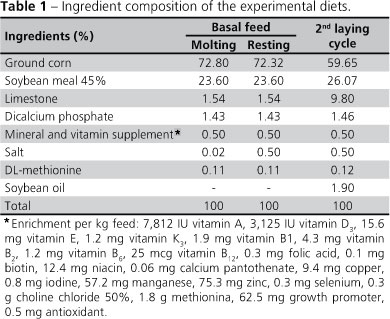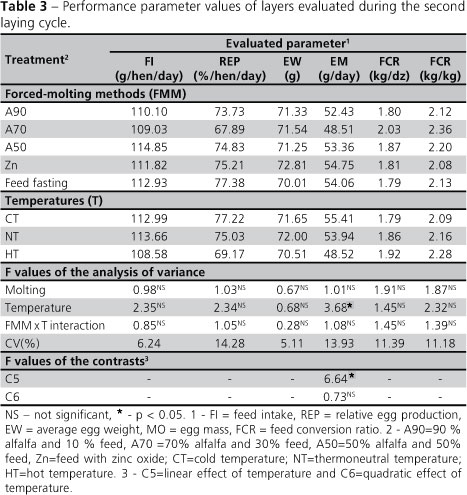Abstract
This study was carried out to evaluate the performance and egg quality of laying hens, in their second laying cycle submitted to different forced-molting methods and three environmental temperatures. Six hundred layers were distributed in a completely randomized experimental design with 15 treatments with five replicates of eight birds each, according to 5x3 factorial arrangement (molting methods vs. temperatures). The following forced-molting methods were applied: 90%, 70%, 50% dietary alfalfa inclusion, addition of 2,800 ppm zinc, and feed fasting. Temperatures were: 20 ºC, 27 ºC and 35 ºC. At the end of each period of the second laying cycle, bird performance and egg quality were evaluated. Data were submitted to analysis of variance and means were compared by orthogonal and polynomial contrasts. The highest alfalfa inclusion level (90% alfalfa and 10% basal diet) proved to be efficient as compared to the other methods, independently of temperature.
Egg quality; heat stress; performance; welfare
Performance of layers submitted to different forced-molting methods and different temperatures1 Mail Adress: Sarah Sgavioli Rua Carlos Buck, 313 Santa Tereza 14.883-292. Jaboticabal, SP, Brasil E-mail: sarahsgavioli@yahoo.com.br
Sgavioli SI; Filardi R da SII; Praes MFFMI; Assuena VI; Pileggi JI; Andrade P de CI; Boleli I CI; Junqueira OMI
IUniversidade Estadual Paulista Júlio de Mesquita Filho. Jaboticabal, SP, Brasil
IIUniversidade Estadual Paulista Júlio de Mesquita Filho. Ilha Solteira, SP, Brasil
Mail Adress Mail Adress: Sarah Sgavioli Rua Carlos Buck, 313 Santa Tereza 14.883-292. Jaboticabal, SP, Brasil E-mail: sarahsgavioli@yahoo.com.br
ABSTRACT
This study was carried out to evaluate the performance and egg quality of laying hens, in their second laying cycle submitted to different forced-molting methods and three environmental temperatures. Six hundred layers were distributed in a completely randomized experimental design with 15 treatments with five replicates of eight birds each, according to 5x3 factorial arrangement (molting methods vs. temperatures). The following forced-molting methods were applied: 90%, 70%, 50% dietary alfalfa inclusion, addition of 2,800 ppm zinc, and feed fasting. Temperatures were: 20 ºC, 27 ºC and 35 ºC. At the end of each period of the second laying cycle, bird performance and egg quality were evaluated. Data were submitted to analysis of variance and means were compared by orthogonal and polynomial contrasts. The highest alfalfa inclusion level (90% alfalfa and 10% basal diet) proved to be efficient as compared to the other methods, independently of temperature.
Keywords: Egg quality, heat stress, performance, welfare.
INTRODUCTION
Eggshells present reduced thickness and strength by the end of the first laying cycle, precisely when eggs become heaviest. Forced molting is an economically viable management practice to solve this problem by causing stress, making hens to stop laying (Roland & Brake, 1982).
Forced molting methods include feed and water fasting, light restriction, and chemical agents. Feed withdrawal from the feeders for 10 to 12 days is the easiest method to induce molting in layers (Donalson et al., 2005).
However, despite its good results and easy application, feed fasting is subject of animal welfare concerns due to its aggressiveness of feed fasting, and therefore, less stressful forced-molting methods, such as the dietary inclusion of insoluble fibers, have been investigated (Donalson et al., 2005; Landers et al., 2005; Kwon et al., 2001).
Studies on alternative forced-molting methods have yielded conflicting results due to the variations of responses of birds kept under different environmental conditions. Among the environmental factors, thermal conditions, represented by temperature, humidity, and air movement, have a direct effect on birds, as these not allow birds to maintain constant body temperature (Tinoco, 1995). At temperatures higher than 30 °C, feed intake rapidly drops and energy requirements increase, as birds need to eliminate heat, leading to worse performance (Furlan & Macari, 2002).
Taking these facts into consideration, this study aimed at evaluating the performance and egg quality of commercial layers in their second laying cycle after being submitted to different forced-molting methods at three environmental temperatures.
MATERIALS AND METHODS
The experimental period included the phases of forced molting, resting, and second laying cycle (six periods of 28 days). Birds were selected as a function of body weight and egg production.
In the trial, 600 72-week-old Isa Brown® commercial layers were distributed into 75 experimental units according to a completely randomized experimental design in a 5x3 factorial arrangement (forced-molting method x temperature), with five replicates of eight birds each.
During the forced-molting period, a lighting regime of 12 hours of light/day was adopted. During the resting period, the number of hours of light was increased up to 17 hours of light/day. Feed and water were supplied ad libitum.
Birds were kept in three climatic chambers during the forced-molting period (14 days) and the resting period (28 days), where temperature and maximum and minimum humidity were measured using hygro-thermometers. During the second laying cycle, birds were housed in a conventional layer house.
Five methods of forced-molting were applied: 90% alfalfa and 10% feed (A90); 70% alfalfa and 30% feed (A70); 50% alfalfa and 50% feed (A50); feed with the addition of 2,800 ppm zinc (Zn) and feed fasting (control).
The following temperatures were applied: cold temperature (CT): 20 ºC; thermoneutral temperature (NT): 27 ºC; hot temperature (HT): 35 ºC.
During the second laying cycle, at the end of each period, the following performance parameters were evaluated: feed intake, egg production, average egg weight (total egg weight divided by the number of eggs produced in each experimental unit), egg mass (egg production percentage multiplied by respective average egg weight) and feed conversion ratio (kg feed/kg eggs and kg feed/dozen eggs). Egg quality was evaluated as to Haugh units (100 log (h + 7.57 - 1.7 W0.37), where h = albumen height in mm and W = egg weight in grams and eggshell percentage and thickness. Egg specific gravity was determined using different NaCl solutions with densities between 1.065 and 1.100 g/cm3 in 0.005 increments, according to the recommendations of Moreng & Avens (1990).
Feeds were based on corn and soybean meal and formulated according to the recommendations of Rostagno et al. (2005). Feed ingredient composition is shown in Table 1 and the nutritional composition in Table 2.
The obtained data were submitted to analysis of variance using the General Linear Model (GLM) of SAS® statistical package (SAS Institute, 2002). When significant effects were determined, means were compared at 5% probability level by orthogonal and polynomial contrasts, as follows: contrast 1 - comparison between the sum of A90, A70 and A50 means versus the sum of Zn and feed fasting means; contrast 2 - linear effect of alfalfa levels; contrast 3 - quadratic effect of alfalfa levels; contrast 4 - comparison between Zn and feed fasting means; contrast 5 -linear effect of temperatures; contrast 6 - quadratic effect of temperatures.
RESULTS AND DISCUSSION
Means, coefficients of variation, F values of analysis of variance, and orthogonal and polynomial contrasts of performance parameters evaluated during the second laying cycle are shown in Table 3.
There was a decreasing linear behavior (p < 0.05) of egg mass as a function of the temperatures in which birds were maintained during the periods of forced-molting and resting. Temperature increases affect feed intake, egg production and feed conversion ratio (Teeter, 1989), and low egg weights are directly related with lower feed intake (Andrade et al., 1976). Layers submitted to heat stress present lower egg production and egg mass (Njoya & Picard, 1994; Mashaly et al., 2004) as compared to those maintained in thermal comfort.
Treatments did not influence the other performance parameters evaluated (p > 0.05).
Means, coefficients of variation, F values of analysis of variance, and orthogonal and polynomial contrasts of egg quality characteristics evaluated during the second laying cycle are shown in Table 4. The lowest alfalfa inclusion levels resulted in a linear decrease (p < 0.05) of Haugh units. Donalson et al. (2005), in a similar experiment, using different alfalfa dietary inclusion levels to induce molting, observed higher albumen height values (a characteristic directly related to Haugh units) in hens fed lower alfalfa levels as compared to the other treatments
Eggshell percentage, eggshell thickness, and egg specific gravity did were not influenced by the treatments (p > 0.05).
CONCLUSIONS
Increasing temperatures reduced egg mass; however, the evaluated forced-molting methods and temperatures to which the birds were submitted did not influence the other performance parameters. The method using the highest alfalfa inclusion level (90% alfalfa and 10% feed) was more efficient, relative to egg quality, than the other alfalfa inclusion levels, independently of temperature.
Submitted: November/2010
Approved: July/2011
1 Study funded by Fapesp. Processes n: 07/555970-3 and 07/56447-2.
- Andrade AN de, Roger JC, Featherston WR. Influence of constanelevated temperature and diet on egg production and shell quality. Poultry Science 1976; 55:685-693.
- Donalson LM, Herrera P. Utilizing different ratios of alfalfa and layer ration for molt induction and performance in commercial laying hens. Poultry Science 2005;84:362-369.
- Furlan RL, Macari M. Termorregulação. In: Macari M, Furlan RL, Gonzáles E. Fisiologia aviária aplicada a frangos de corte. 2 ed. Jaboticabal: Funep; 2002. p.209-230.
- Kwon YM, Kubena LF, Woodward CL. Use of an alfalfa diet for molting in leghorn hens to reduce Salmonella enteritidis colonization and invasion. Poultry Science 2001; 80(suppl 1):90 2001.
- Landers KL, Woodward CL, Li X. Alfalfa as a single dietary source for molt induction in laying hens. Bioresource Technology 2005; 96:565-570.
- Mashaly MM, Hendricks GL, Kalama MA. Effect of heat stress on production parameters and immune responses of commercial laying hens. Poultry Science 2004; 83:889-894.
- Moreng RE, Avéns JS. Ciência e produção de aves. São Paulo: Roca; 1990. 380p.
- Njoya J, Picard M. Climatic adaptation of laying hens. Tropical Animal Health Production 1994; 26:180-186.
- Roland DA, Brake JH. Influence of premolt production on postmolt performance with explanation for improvement in egg production due to force molting. Poultry Science 1982; 61(12):2473-2481.
- Rostagno HS, Albino LFT, Donzele JL. Tabelas brasileiras para aves e suínos: composição de alimentos e exigências nutricionais. 3ed. Viçosa: UFV; 2005.
- SAS. Institute user' guide: statistics. Cary; 2002.
- Teeter RG. Otimização da produtividade em frangos de corte durante o estresse calórico. Anais do 1 Simpósio Técnico Planalquímica; 1989; São Paulo, SP. Brasil. P.17-40. Planalquímica, 1989. p.17-40.
- Tinoco IFF. Estresse calórico - meios naturais de condicionamento. Anais do Simpósio Internacional sobre Ambiência e Instalação na Avicultura Industrial; 1995, Curitiba, Paraná, Brasil. Campinas:Facta; 1995. p.99-108.
Publication Dates
-
Publication in this collection
14 Oct 2011 -
Date of issue
Sept 2011
History
-
Accepted
July 2011 -
Received
Nov 2010





